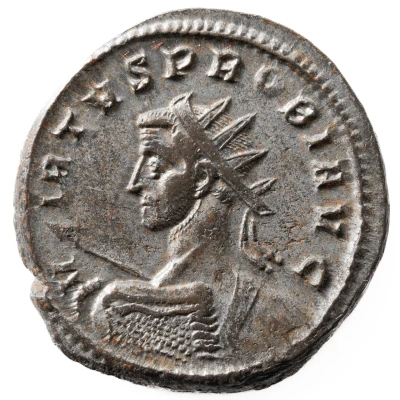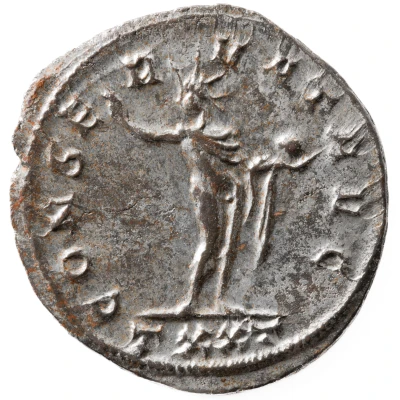Antoninianus - Probus E8 bust; CONSERV T AVG; Sol
278 year| Silver | 4.23 g | 23.77 mm |
| Issuer | Rome › Roman Empire (27 BC - 395 AD) |
|---|---|
| Emperor | Probus (Marcus Aurelius Probus) (276-282) |
| Type | Standard circulation coin |
| Year | 278 |
| Value | Antoninianus (1) |
| Currency | Antoninianus, Reform of Caracalla (AD 215 – 301) |
| Composition | Silver |
| Weight | 4.23 g |
| Diameter | 23.77 mm |
| Shape | Round (irregular) |
| Technique | Hammered |
| Demonetized | Yes |
| Updated | 2024-10-05 |
| Numista | N#374093 |
|---|---|
| Rarity index | 100% |
Reverse
Sol, radiate, standing front, head left, raising right hand and holding globe in left hand.
Script: Latin
Lettering:
CONSERVA AVG or CONSERVAT AVG
-/-//TXXT
Translation:
Conservatori Augusti.
Protector of the emperor.
Comment
This coin depicts the E8 bust of Probus (Bust type according to Pierre Bastiens grouping of bust types): bust of Probus, radiate, helmeted, heroically nude, left, seen from behind, holding spear in right hand and square shield (aegis) in left hand. See for the only known example: probuscoins.fr #1086.The example was minted by the 3th officina (exergue mark TXXT) of Ticinum, as part of the 4th emission and therefore in the year 278 (Karl Pink, Der Aufbau der römischen Münzprägung in der Kaiserzeit VI/I, Wien, 1949).
The E8 bust is not in RIC at all. RIC sometimes mentions a 'square shield' (for example: RIC 388) or even an 'aegis' (for example: RIC 296). However it always mentions Probus 'cuirassed' while the E8 bust is '(heroically) nude'.
This coin with an E8 bust is the second known variant of RIC 351, the other one depicting a F19 bust (see: ). The only difference between the F19 and E8 bust is that the E8 bust is helmeted.
Interesting fact
One interesting fact about the Antoninianus - Probus coin is that it was issued during a time of economic reform and military campaigns. The coin's design, featuring the bust of Probus on the obverse and the personification of Sol on the reverse, symbolizes the emperor's efforts to restore the Roman Empire's economy and military power. Despite being made of silver, the coin's weight and purity varied, reflecting the empire's economic challenges during this period.

